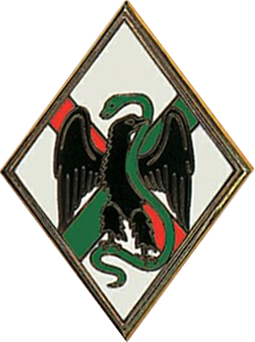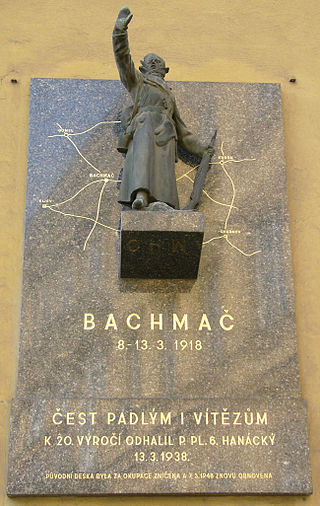
The Czech Armed Forces, also known as the Czech Army, is the military service responsible for the defence of the Czech Republic as part of the Armed Forces of the Czech Republic alongside the Military Office of the President of the Republic and the Castle Guard. The army consists of the General Staff, the Land Forces, the Air Force and support units.

Tomáš Garrigue Masaryk was a Czechoslovak statesman, progressive political activist and philosopher who served as the first president of Czechoslovakia from 1918 to 1935. He is regarded as the founding father of Czechoslovakia.
The 1st Czechoslovak Independent Armoured Brigade Group was an armoured unit of expatriate Czechoslovaks organised and equipped by the United Kingdom during the Second World War in 1943.

The Czechoslovak Legion were volunteer armed forces consisting predominantly of Czechs and Slovaks fighting on the side of the Entente powers during World War I and the White Army during the Russian Civil War until November 1919. Their goal was to win the support of the Allied Powers for the independence of Lands of the Bohemian Crown from the Austrian Empire and of Slovak territories from the Kingdom of Hungary, which were then part of the Austro-Hungarian Empire. With the help of émigré intellectuals and politicians such as the Czech Tomáš Garrigue Masaryk and the Slovak Milan Rastislav Štefánik, they grew into a force over 100,000 strong.

Ludvík Svoboda was a Czech general and politician. He fought in both World Wars, for which he was regarded as a national hero, and he later served as the president of Czechoslovakia from 1968 to 1975.

Polish 5th Siberian Rifle Division was a Polish military unit formed in 1919 in Russia during the aftermath of World War I. The division fought during the Polish-Soviet War, but as it was attached to the White Russian formations, it is considered to have fought more in the Russian Civil War. Its tradition was continued in the Polish Army as the 30th Infantry Division.

The 1st Foreign Regiment is a depot regiment of the Foreign Legion in the French Army. It is located at Aubagne.

The Battle of Zborov was a part of the Kerensky Offensive. The battle was the first significant action of the Czechoslovak Legions on the Eastern Front.

Battle of Bakhmach, was one of the last battles on the Eastern Front in World War I between the Entente-backed Czechoslovak Legion, Soviet Russia and the Central Powers occupying Ukraine after the Treaty of Brest-Litovsk. The battle lasted from March 8 to March 13, 1918 over the city of Bakhmach (Бахмач), today in Ukraine and was the last engagement in World War I for the Soviets. Following a Legion victory, the Germans negotiated a truce.

The Foreign Legion has had a long and unique history amongst the units of the French Army. It was historically formed of expatriate enlisted personnel led by French officers. Founded by a royal ordinance issued by King Louis Philippe of France on March 9, 1831, with the aim of bolstering the strength of the French Army while also finding a use for the influx of refugees inundating France at the time. The Foreign Legion subsequently found a permanent home in the ranks of the French military. The Foreign Legion's history spans across the Conquest of Algeria, the Franco-Prussian War, numerous colonial exploits, both World Wars, the First Indochina War, and the Algerian War.

The 1st Free French Division was one of the principal units of the Free French Forces (FFL) during World War II, renowned for having fought the Battle of Bir Hakeim.
The Czechoslovak 11th Infantry Battalion – East was a Czechoslovak infantry battalion in the Second World War. It served under the British Middle East Command in the Mediterranean and Middle East Theatre.

The Czechoslovak Army was the name of the armed forces of Czechoslovakia. It was established in 1918 following Czechoslovakia's declaration of independence from Austria-Hungary.

The Czechoslovak-Polish War, widely known in Czech sources as the Seven-Day War was a military confrontation between Czechoslovakia and Poland over the territory of Cieszyn Silesia in early 1919.

Sergey Nikolayevich Voytsekhovsky was a Colonel of the Imperial Russian Army, Major-General in the White movement, and Czechoslovak Army general. He was a participant in the Great Siberian Ice March.

Stanislav Čeček was a Czechoslovak general.

The Czechoslovak Italian Legion was a legion of Czechoslovak volunteers formed late in World War I. The first formal Czechoslovak Volunteers Group was formed in Italian prisoner-of-war camps in Santa Maria Capua Vetere, near Naples and matured at Padula near Salerno. In January 1918, the headquarters of the 6th Italian Army finally agreed to form reconnaissance squadrons from Czechoslovak and Southern Slav volunteers. In September 1918, the 39th Regiment of the Czechoslovak Italian Legion was formed from those volunteer reconnaissance squadrons. The following regiments of Czechoslovak Italian Legion were formed in April and May 1918:
The Moroccan Division or the 1st Moroccan Division of 1914, initially the Marching Division of Morocco was an infantry division of France's Army of Africa which participated in World War I.

The 21st Infantry Regiment "Cremona" is an inactive unit of the Italian Army last based in Alessandria in Piedmont. The regiment is named for the city of Cremona and part of the Italian Army's infantry arm. The regiment was formed in 1848 by the Royal Sardinian Army during the First Italian War of Independence. After the war the regiment was disbanded. In 1859, the regiment was reformed after the Kingdom of Sardinia annexed Lombardy after the Second Italian War of Independence. In 1866, the regiment fought in the Third Italian War of Independence. During World War I the regiment fought on the Italian front.

The Battle of Terron, sometimes referred to as the Battle of Vouziers, was a World War I battle during which the Czechoslovak Rifle Brigade of the Czechoslovak Legion in France was deployed around the French town of Terron. This brigade successfully fought against the German troops and successfully defended the captured positions.


















